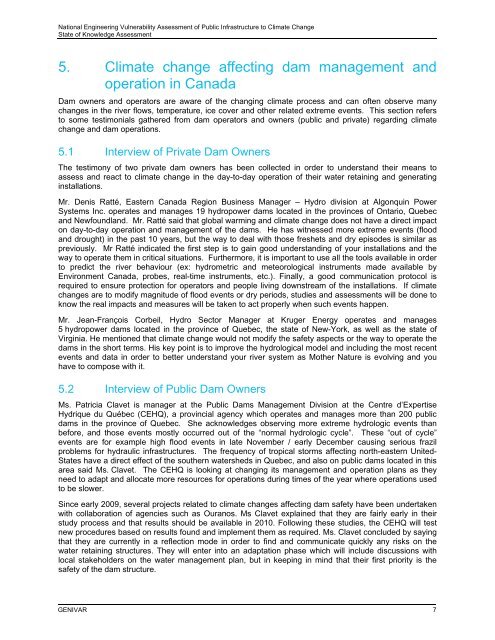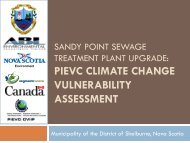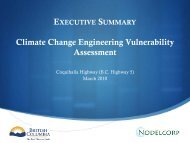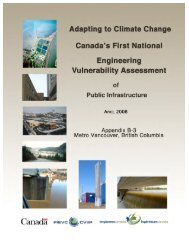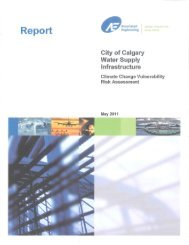Final Report - Vulnerability Committee
Final Report - Vulnerability Committee
Final Report - Vulnerability Committee
You also want an ePaper? Increase the reach of your titles
YUMPU automatically turns print PDFs into web optimized ePapers that Google loves.
National Engineering <strong>Vulnerability</strong> Assessment of Public Infrastructure to Climate ChangeState of Knowledge Assessment5. Climate change affecting dam management andoperation in CanadaDam owners and operators are aware of the changing climate process and can often observe manychanges in the river flows, temperature, ice cover and other related extreme events. This section refersto some testimonials gathered from dam operators and owners (public and private) regarding climatechange and dam operations.5.1 Interview of Private Dam OwnersThe testimony of two private dam owners has been collected in order to understand their means toassess and react to climate change in the day-to-day operation of their water retaining and generatinginstallations.Mr. Denis Ratté, Eastern Canada Region Business Manager – Hydro division at Algonquin PowerSystems Inc. operates and manages 19 hydropower dams located in the provinces of Ontario, Quebecand Newfoundland. Mr. Ratté said that global warming and climate change does not have a direct impacton day-to-day operation and management of the dams. He has witnessed more extreme events (floodand drought) in the past 10 years, but the way to deal with those freshets and dry episodes is similar aspreviously. Mr Ratté indicated the first step is to gain good understanding of your installations and theway to operate them in critical situations. Furthermore, it is important to use all the tools available in orderto predict the river behaviour (ex: hydrometric and meteorological instruments made available byEnvironment Canada, probes, real-time instruments, etc.). <strong>Final</strong>ly, a good communication protocol isrequired to ensure protection for operators and people living downstream of the installations. If climatechanges are to modify magnitude of flood events or dry periods, studies and assessments will be done toknow the real impacts and measures will be taken to act properly when such events happen.Mr. Jean-François Corbeil, Hydro Sector Manager at Kruger Energy operates and manages5 hydropower dams located in the province of Quebec, the state of New-York, as well as the state ofVirginia. He mentioned that climate change would not modify the safety aspects or the way to operate thedams in the short terms. His key point is to improve the hydrological model and including the most recentevents and data in order to better understand your river system as Mother Nature is evolving and youhave to compose with it.5.2 Interview of Public Dam OwnersMs. Patricia Clavet is manager at the Public Dams Management Division at the Centre d’ExpertiseHydrique du Québec (CEHQ), a provincial agency which operates and manages more than 200 publicdams in the province of Quebec. She acknowledges observing more extreme hydrologic events thanbefore, and those events mostly occurred out of the “normal hydrologic cycle”. These “out of cycle”events are for example high flood events in late November / early December causing serious frazilproblems for hydraulic infrastructures. The frequency of tropical storms affecting north-eastern United-States have a direct effect of the southern watersheds in Quebec, and also on public dams located in thisarea said Ms. Clavet. The CEHQ is looking at changing its management and operation plans as theyneed to adapt and allocate more resources for operations during times of the year where operations usedto be slower.Since early 2009, several projects related to climate changes affecting dam safety have been undertakenwith collaboration of agencies such as Ouranos. Ms Clavet explained that they are fairly early in theirstudy process and that results should be available in 2010. Following these studies, the CEHQ will testnew procedures based on results found and implement them as required. Ms. Clavet concluded by sayingthat they are currently in a reflection mode in order to find and communicate quickly any risks on thewater retaining structures. They will enter into an adaptation phase which will include discussions withlocal stakeholders on the water management plan, but in keeping in mind that their first priority is thesafety of the dam structure.GENIVAR 7


